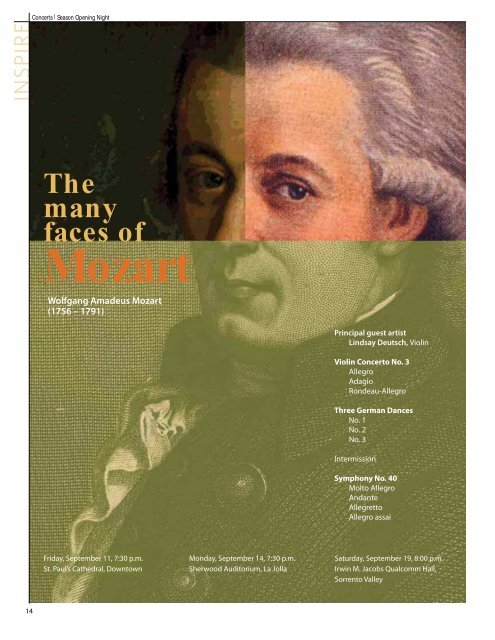The Stars of our Orchestra - Orchestra Nova San Diego
The Stars of our Orchestra - Orchestra Nova San Diego
The Stars of our Orchestra - Orchestra Nova San Diego
Create successful ePaper yourself
Turn your PDF publications into a flip-book with our unique Google optimized e-Paper software.
14<br />
Concerts | Season Opening Night<br />
<strong>The</strong><br />
many<br />
faces <strong>of</strong><br />
Mozart<br />
Wolfgang Amadeus Mozart<br />
(1756 – 1791)<br />
Friday, September 11, 7:30 p.m.<br />
St. Paul’s Cathedral, Downtown<br />
Monday, September 14, 7:30 p.m.<br />
Sherwood Auditorium, La Jolla<br />
Principal guest artist<br />
Lindsay Deutsch, Violin<br />
Violin Concerto No. 3<br />
Allegro<br />
Adagio<br />
Rondeau-Allegro<br />
Three German Dances<br />
No. 1<br />
No. 2<br />
No. 3<br />
Intermission<br />
Symphony No. 40<br />
Molto Allegro<br />
Andante<br />
Allegretto<br />
Allegro assai<br />
Saturday, September 19, 8:00 p.m.<br />
Irwin M. Jacobs Qualcomm Hall,<br />
Sorrento Valley<br />
It was 1761 in Salzburg, Austria, and the little five-year old boy named Joannes<br />
Chrysostomos Wolfgangus <strong>The</strong>ophilus Mozart (later called Wolfgang Amadeus Mozart)<br />
danced his way into the hearts <strong>of</strong> those in the audience with his first appearance as a<br />
public performer. <strong>The</strong> occasion was a celebration <strong>of</strong> the end <strong>of</strong> the academic year and the<br />
play was “Sigismundus Rex.” This was a banner year for the little boy. He had been playing<br />
the violin and piano for a couple <strong>of</strong> years, and had just composed his first piece <strong>of</strong> music.<br />
Three years later, he had composed his first symphony and had already performed<br />
throughout Europe, including highly acclaimed appearances before royalty.<br />
A life cut short<br />
During the next 27 years, there were very few Europeans throughout the continent who<br />
weren’t aware <strong>of</strong> the “many faces <strong>of</strong> Mozart,” for he was recognized as an exceptionally talented<br />
composer and performer. Tragically, he died at the age <strong>of</strong> 35, probably <strong>of</strong> rheumatic fever,<br />
although recent studies indicate he may have died <strong>of</strong> “strep throat.”<br />
Looking at the many faces <strong>of</strong> Mozart<br />
It’s a fact that the most successful composers throughout history could “do many things” —<br />
Wolfgang Amadeus Mozart was no exception, and he did them very well!<br />
<br />
<br />
symphonies, operas, chamber music, choral music, concertos and dances.<br />
<br />
<br />
<br />
contrapuntal works.<br />
<br />
England, Germany and France.<br />
<br />
borrowing money from friends.<br />
<br />
Salzburg<br />
Violin Concerto No. 3<br />
If only you would focus<br />
<strong>The</strong> son <strong>of</strong> a violin teacher, Mozart was<br />
trained to play the violin before he was<br />
five and he became very pr<strong>of</strong>icient at<br />
playing the instrument, but his heart<br />
seemed to be elsewhere. His father,<br />
Leopold Mozart, once wrote that his son<br />
could be the best violinist in Europe if<br />
only he would put his mind to it.<br />
However, it’s doubtful that he would<br />
have been hired to be the konzertmeister<br />
and organist at the c<strong>our</strong>t <strong>of</strong> Archbishop<br />
Colloredo in Salzburg had he not been an<br />
exceptional violinist.<br />
Here are y<strong>our</strong> violin concertos —<br />
now I’m <strong>of</strong>f to Mannheim<br />
He only wrote five violin concertos, and<br />
it is believed that they were written<br />
between 1773 and 1777 during his<br />
tenure with Archbishop Colloredo. Mozart<br />
wrote them knowing that he would play<br />
the part <strong>of</strong> the soloist. Shortly after he<br />
finished writing Violin Concerto No. 5, he<br />
resigned his commission. <strong>The</strong> 21-year-old<br />
composer was ready to write operas and<br />
Salzburg wasn’t that interested in operas.<br />
He never wrote another violin concerto.<br />
<strong>The</strong> most beautiful <strong>of</strong> all<br />
Violin Concerto No. 3 is far more<br />
sophisticated than the first two<br />
concertos so it is widely believed<br />
that there was at least a two-year gap<br />
between Concerto No. 2 and Concerto<br />
No. 3, the most popular <strong>of</strong> the five. Most<br />
scholars agree that Mozart reached his<br />
full maturity when he composed this<br />
concerto.<br />
Mozart built his concertos around a<br />
beautiful melody, allowing the soloist to<br />
take on the role <strong>of</strong> a singer. In his mind,<br />
instrumental solo concertos were closely<br />
related to operatic arias. <strong>The</strong> Adagio<br />
movement <strong>of</strong> this concerto is <strong>of</strong>ten<br />
considered to be the most beautiful<br />
and quintessential Mozart <strong>of</strong> any <strong>of</strong> his<br />
compositions.<br />
15


